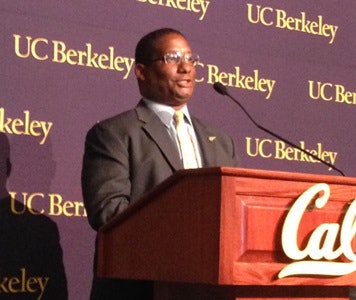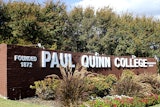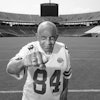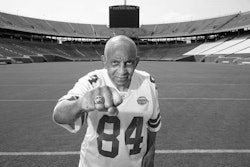 Cal Athletic Director H. Michael Williams says that “only 2 percent of college athletes will ever see a paycheck from pro sports, so we need to do better at convincing them of the value of diplomas.”
Cal Athletic Director H. Michael Williams says that “only 2 percent of college athletes will ever see a paycheck from pro sports, so we need to do better at convincing them of the value of diplomas.”When H. Michael Williams began at the University of California, Berkeley in the late 1970s, he made friends easily. He was a student-athlete who had plenty of interaction with non-athletes.
“We each had roommates who were non-athletes, and many of those people are still in my life today,” Williams recalls.
It’s these coming-of-age experiences, along with a top-notch education, that Williams, who was appointed full-time director of athletics earlier this year, is trying to make more accessible to students who play in one of UC-Berkeley’s 30 intercollegiate sports.
Athletes make up more than 25 percent of African-American students at the institution that bills itself as the premier, public university in this country. But in recent years, many of the Black athletes have described feeling cut off from the rest of the student body and dissatisfaction with being limited to other athletes as their dorm roommates.
Although Williams did not necessarily experience the same sort of isolation as an undergraduate, “I was here (at Berkeley) when there were very few Black men. Every day in my career, I have been the only Black man wherever I was.”
A 1982 alumnus, Williams was a longtime philanthropist, university volunteer and vice chairman of the university foundation’s board, which completed a $3 billion-plus campus-wide fundraising campaign. He worked for more than two decades in finance, mostly in the San Francisco area, retiring in 2009 as vice chair of capital markets for Barclays Global Investors. Previous career stops included being a debt trader and corporate finance officer for Bank of America.
He was tapped as UC-Berkeley athletics director after holding the post for nearly a year on an interim basis. Although he initially voiced no aspirations for the permanent position, he had a change of heart when Chancellor Nicholas Dirks sold him on the idea. Simultaneously, he found himself won over during the course of becoming acquainted with many of the 850 student-athletes.
“It’s very appealing, the idea of taking someone from ages 17 to 22 and helping to shape them,” says Williams, who adds that plenty of his children’s school teachers, coaches and health care providers have turned out to be former UC-Berkeley athletes.
Williams leads a division that was rocked by a 2013 NCAA report revealing that, at one point, the university had the worst graduation rate of football players among the nation’s 72 major conference schools. Only 44 percent of football players enrolled between 2003 and 2006 graduated within six years. Meanwhile, only 38 percent of the university’s men’s basketball players during that time period graduated within six years.
Academic performance among revenue sport athletes has since improved. As recently as the 2013-14 school year, which concluded shortly before Williams became interim AD, UC-Berkeley scored a collective 941 out of 1,000 possible points in its academic progress rate of football players, an NCAA statistic that accounts for the eligibility and retention of athletes. However, the 2013 NCAA report worried Dirks to the point that he convened a task force on academics and athletics in early 2014 to study the problem. The group issued 50-plus recommendations.
“Graduation is very important to me,” says Williams, who was a task force member. “There was a time here, when maybe it was not so important. We as a campus haven’t always done a good job selling the value of the diploma. But only 2 percent of college athletes will ever see a paycheck from pro sports, so we need to do better at convincing them of the value of diplomas.”
So far, his department has completed half of the 15 task force recommendations that were specific to intercollegiate athletics.
For instance, a full-time athletic recruitment coordinator has been hired, Williams says. The coordinator can help high school athletes better prepare for the academic rigors of college by suggesting and elaborating on what courses to take before graduation if they’re considering UC-Berkeley.
Williams plans to repeat a “Back to School” initiative with university head coaches that occurred last year. The coaches sat in on classes for several days in order to gain a deeper understanding of what athletes must juggle. Williams recalls how the classroom visits opened the eyes of one coach, who had mistakenly presumed that a freshman, English composition course required students to produce a one- or two-page paper. Instead, the course called for a five-page paper—with multiple drafts. A new draft was due every two weeks.
Williams isn’t bothered by the fact that this is his first sports management job. He points out that four of 12 ADs in the Pac-12, including himself, were hired from outside the profession.
“It’s not as unusual as it may seem,” he says. “The job is growing increasingly complicated in today’s legal and regulatory environment. What I do involves finance and managing personnel. It’s more than just managing coaches.”
Dirks agreed when he tapped Williams for the permanent position, calling him “far and away the person best positioned and equipped.”
“Mike’s deep experience with the management and financial operations of complex organizations are clearly invaluable assets,” the chancellor said at the time. “Mike understands, on both a human and organizational level, the unique interests, needs and challenges that must be addressed so that student-athletes can thrive.”
His father was a Howard University letterman in wrestling, and Williams excelled at the sport in high school in Fresno, Calif., winning the equivalent of all-state honors. As a Berkeley undergraduate, he worked his way up to the wrestling program’s second team, but the sport was canceled after his freshman year.
Nevertheless, Williams can still relate to the time management pressures that athletes at elite institutions face. “My freshman year, close to Thanksgiving, we had a wrestling match at the San Jose State University arena,” he recalls. “We were heading toward exams week, and I was reading ‘The Canterbury Tales’ at the time.”
In recent years, African-American students, and not just athletes, have called on the administration to provide them with better support. Blacks now make up only 3 percent of Berkeley undergraduates and 4 percent of graduate students. This semester, the university announced plans to establish a $20 million, privately-run scholarship fund to try attracting a critical mass of Black students as a steppingstone.
Dirks’ task force also mentioned the problem in its 2014 report.
“It is not surprising that our Black athletes report being stigmatized, stereotyped and lacking a wider community,” the report stated. “Issues surrounding the admission and support for students from underrepresented groups require strong and pro-active support from the highest administrative levels. Circumstances (surrounding) Black student-athletes, especially in revenue sports, are crucial concerns. Faculty need to engender a more inclusive engagement.”
Even before becoming interim AD in 2014, Williams took the initiative in supporting the success of Blacks at his alma mater. He and his wife have made charitable gifts endowing scholarships and a faculty position in African-American studies.
“We have a tremendous opportunity before us,” he says. “Let’s not make it as lonely for this generation of underrepresented minorities.”
He adds: “If you come to Berkeley, make Berkeley work for you.”


















